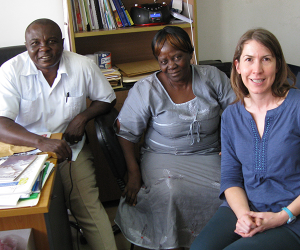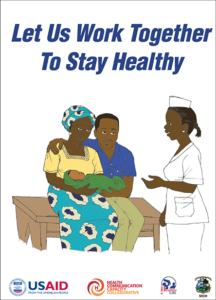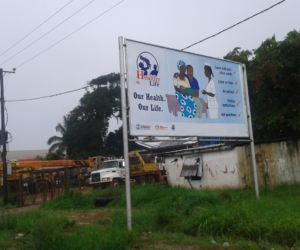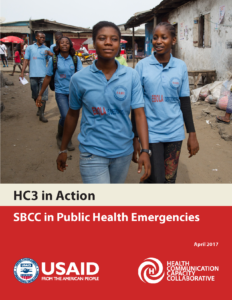A Unique Angle in Addressing the Gap between Healthcare Workers and Clients
Social and behavior change communication programming around service delivery often focuses on one side of the equation – the providers.
In Liberia, the Health Communication Capacity Collaborative (HC3) and partners worked after the Ebola crisis with service providers as well as patients to improve care and introduce more compassion into the experience of visiting a health clinic.
Two Components – Compassion and Community Engagement

Anna Helland, far right, in the HC3 Monrovia field office with Marietta Yekeh (center) and Teah Doegmah (left)
HC3 Liberia’s campaign to rebuild trust in the health system after the world’s worst Ebola outbreak promoted compassion for healthcare workers by recognizing their often-difficult working conditions. The campaign sought to bridge a divide that grew ever larger throughout the outbreak and after.
Still recovering from a devastating 14-year civil war, Liberia, along with Guinea and Sierra Leone, faced an Ebola outbreak that quickly became the deadliest occurrence since the discovery of Ebola virus disease (EVD) in 1976. As the outbreak continued into 2015, trust between healthcare workers and the communities they served continued to erode, with both sides fearing the other and many clinics closing their doors. The health system, which had just begun to improve during the first decade of peace, faced 10,000 EVD cases and almost 5,000 deaths by the time Liberia was declared Ebola-free for the last time in January 2016. Healthcare workers were among those at highest risk for contracting the disease, and the country lost 8% of its health workers to Ebola.
Against this backdrop of distrust and upheaval, HC3 implemented a campaign to rebuild trust in the health system and to promote the service providers who were back to work and attempting to serve the healthcare needs of a country recovering from the immense health and socioeconomic impact of the outbreak. Having launched the Healthy Life brand with Liberia’s Ministry of Health in June 2016, HC3 employed a mass media approach to support the brand and partnered with the USAID-funded Partnership for Advancing Community Based Services (PACS) project to promote trust and caring between healthcare workers and clients through compassion and community engagement.
The Compassion Campaign
 The Compassion campaign took a unique angle in addressing the gap between healthcare workers and their clients by focusing not on what service providers can do but what mothers can do to improve the quality of clinic visits. We asked the question, “What could a mom do better?”
The Compassion campaign took a unique angle in addressing the gap between healthcare workers and their clients by focusing not on what service providers can do but what mothers can do to improve the quality of clinic visits. We asked the question, “What could a mom do better?”
This focus brought attention to the stress many healthcare workers were under, from mourning the deaths of their colleagues who became infected with EVD to the current landscape where health facilities are often under-staffed, face limited drug supply and stock outs and function without consistent electricity or running water.
 Through mass media and support by community-based activities implemented by PACS, the Compassion campaign aimed to increase the proportion of mothers who:
Through mass media and support by community-based activities implemented by PACS, the Compassion campaign aimed to increase the proportion of mothers who:
- Make it easier for the healthcare worker by bringing her health cards, following instructions and asking for clarification if not understanding
- Forgive the healthcare worker for past bad experiences
- Go to their community health committee, community health development committee or community leader when there are issues
- Tell others about their good experiences at the clinic
A series of three radio spots was the cornerstone of the Compassion campaign, with various media and print materials supporting the message of “Let us work together to stay healthy.” HC3 distributed flyers through health facilities and in newspapers, provided posters for health facilities and communities and erected billboards in the six USAID-focus counties which encouraged mothers to:
- Come with their clinics cards
- Come on time
- Be patient
- Follow instructions
- Ask questions
Positive Results
An endline evaluation which surveyed 2,320 women, ages 18 to 49 with children under 5 years of age, found that 47% of the mothers could identify at least three of the nine activities and materials from the Healthy Life brand and subsequent campaigns, which was identified as high exposure.
Mothers with high exposure had almost two times the odds of going to a health facility in the past six months for their or their children’s health needs, as compared to mothers with no or low exposure. Each additional campaign message resulted in approximately 20% higher odds of going to a health facility in the past six months, as compared to women with no or low exposure, and mothers with high exposure had 34% higher odds of going to a health facility when their child had a fever in the past six months, as compared to mothers with no or low exposure to HC3 materials and activities.
The survey also found a number of statistically significant associations (p<0.05) between high exposure to Healthy Life and subsequent campaigns and positive perceptions and attitudes:
72 percent of mothers with high exposure stated they had a positive perception toward health facilities, compared to 68 percent with no or low exposure
43 percent of women with high exposure noted changed attitudes toward health facilities, compared with 27 percent with no or low exposure
92 percent of women with high exposure stated a preference for facility-based health providers for newborn care, compared to 88 percent with no or low exposure
Stronger links
HC3’s campaigns within the Healthy Life brand emphasized trust, partnership and compassion for healthcare workers which in turn has resulted in stronger links between the community and health facility, more compassion for healthcare workers and a shrinking gap between service providers and the communities they serve. While Liberia continues to work towards a more resilient health system, the country will need to depend on these stronger relationships and continue to foster true partnerships between clients and their healthcare providers.
Community Engagement
A theme of community engagement followed from Compassion with radio messages on communities working together with their health facilities and a series of district-level advocacy meetings. Diverse groups, including health facility staff, district leaders, traditional leaders, general community health volunteers and representatives from women’s groups, youth groups, transport unions and market associations gathered to discuss Healthy Life and the concepts of trust, compassion and partnership.









Leave a Reply
Want to join the discussion?Feel free to contribute!